On a Road to Nowhere
Africa
This journey took place shortly before Coronavirus shuttered the world. It was a time of plague.
But it touched the south-west African desert land of Namibia relatively lightly. The land is vast and the population is sparse. The virus had very little business to do.
The journey I will relate does not, in a proper sense, have a destination. But it has a purpose.
The end point will be the abandoned desert wastes of the Sperrgebiet (Forbidden Zone). There’s no-one there. The Sperrgebiet has no people. Those, such as our band of seekers after nothing, may stay for no more than a few hours, and then only by special permission, under supervision. It is nearly the size of Belgium.
There once were people, nearly two thousand, around a hundred years ago. My purpose in going there, with my companions, is to stand in the ghost towns they left behind when their dreams died. I want to feel the emptiness in the dry air of this land of human folly. I want to hear the dead echoes of the frantic scramble for the diamonds that brought the desperate seekers, and the illusory promise of riches. I want to place myself in a still point in the manic world, beyond politics, war, flood, famine, hatred, love and climate change. I want to be where the cruelty of hope once flourished, then died.
On the long road there I wanted to visit the half-alive settlements where hardy people persist in wresting a living from almost nothing, and find out why.
Namibia is a land in which you could get lost. It is nearly as large as France and Germany together, with only around two percent of their combined population. The term ‘population density’ doesn’t really have a meaning in Namibia. If you were to lose your bearings, it might be some time before there’ll be someone to ask the way. Or, even, anyone to ask at all.
It is a land that facinates beyond the facts of its existence. It inspires a passion in its inhabitants and travellers leave feeling they have been somewhere unique. Which, of course, they have.
Writers have invented evocative phrases for Namibia: “the land that time forgot” and “the land that God made in anger”.

SWAKOPMUND has been pushed by the vast and trackless Namib Desert to cling awkwardly to a strip of the western coast of Namibia. It is isolated. With the desert at its back, it shelters from the southern dunes and arid backlands and the Sperrgebiet (Forbidden Zone) to the south. My companions and I will soon be travelling into this empty land. To Swakopmund’s north lies the Skeleton Coast, named after the many ships that have met their doom on the shifting shores and now lie as wrecks on the beaches and the near-inland.
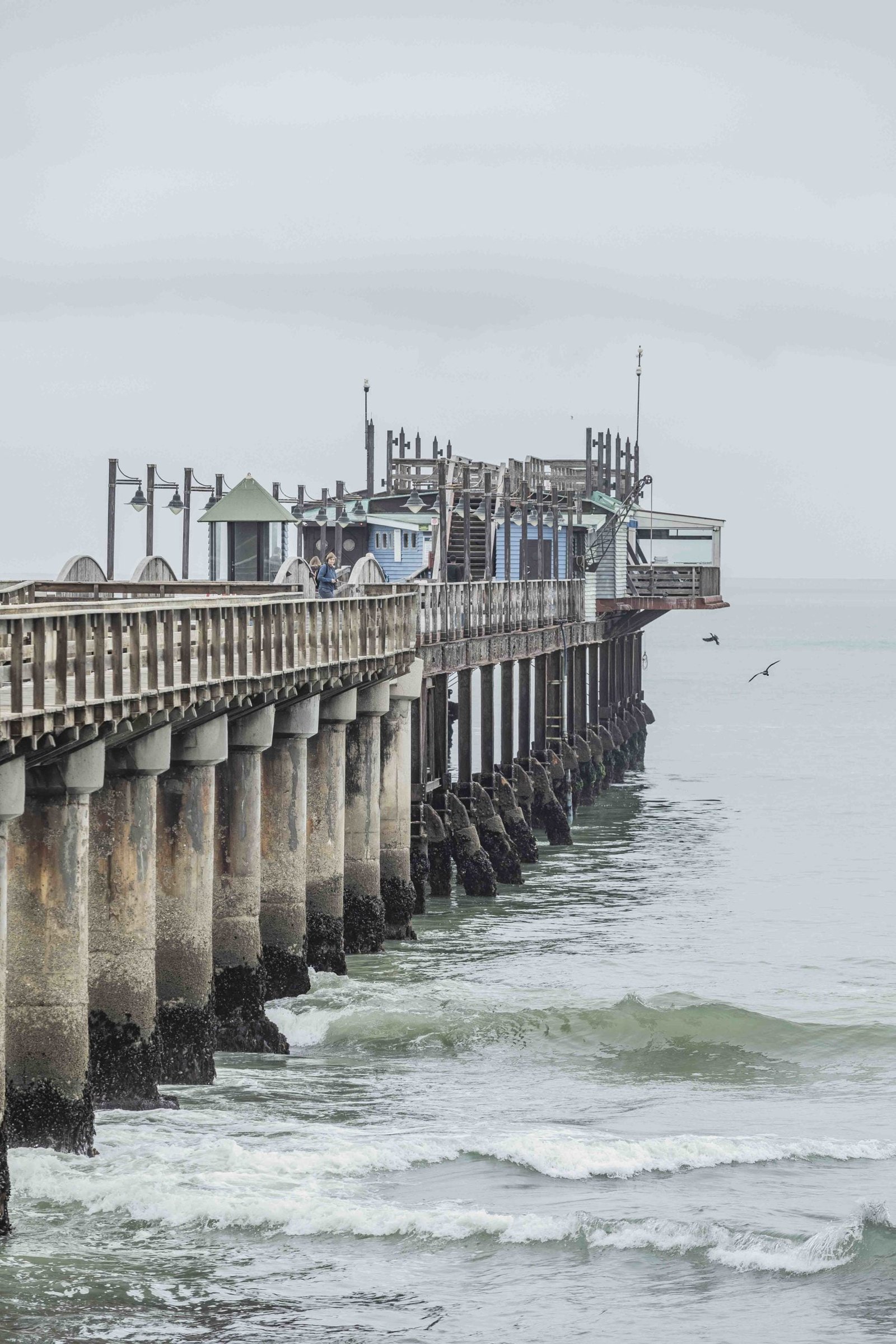
Swakopmund strikes a newcomer as out of place and out of time. There shouldn’t, by rights, be a Gothic-looking town from the age of the kaiser in the desert, in Africa. It shouldn’t look like a film set waiting for a camera crew and actors in period dress. But it does.
It shouldn’t have the charm of yesteryear with food items, for example, that have slipped from modern menus – like great hunks of eisbein (pork knuckle), still one of my own favourites, served with lashings of mustard and tankards of foaming German lager. (Oh, stop me.) Nor should it have Herero women in their elaborate, stylised colonial-inspired garb, nor German folk speaking a blend of quaint, dated German mixed with Afrikaans.
. . . But it does.
The town today has reinvented itself after a difficult past. It has gone from being a pawn in the 19th century scramble for Africa, then embroiled in a global war between distant superpowers; then the loss of its colonial parent and, finally, constricted into apartheid, the unforgiving racial social engineering of a new custodial parent, South Africa. This is a burdensome heritage.
But the Namibians of today, and the emerging people of Swakopmund, who provide service in the eateries, the hotels, the wilderness resorts and, increasingly, the developing economy are the first generation who are doing all these things on their own terms. And I say they are doing a decent job of it. It’s uplifting to be among people who believe they have a future.
A restorer of time

UNDER the blanketing skies of Swakopmund I found Jürg Zabel, a patient and meticulous craftsman, engaged in a labour of love.
He was fixing cannon fire damage to a colonial building along the beach and he was not in a hurry. The damage had been inflicted more than 100 years before by a British warship hoping to dislodge the Germans of the town in the early stages of World War l. The battleship launched a paltry salvo from the sea which had almost no effect because the townspeople, anticipating the British intentions, had decamped into the desert. No one was hurt.
There was, however, damage to a radio mast and to the observation buttress Jürg Zabel was now working on. Since all of this was more than 100 years ago there didn’t seem to be any deadline to the work. I asked: “How long do you think this restoration will take, Jürg?”Jurg shrugged. I should have expected that. We were in the land of slow. Jürg seemed to feel more of an explanation was needed. “Repairing damage to a historic building is like tending to a wound,” he said helpfully.
Amen to that.
Waiting for goodfellows
LIKE Jürg I was not in a hurry. I was waiting for the companions who would join me in a journey we planned to take into the southern desert.
The purpose would lie more in the journey than in the destination. For there wasn’t anything where we were going. The Sperrgebiet was an area meaningfully larger than Wales, and is the now-desolate territory where one of history’s largest-ever diamond strikes occurred. It was still minimally worked. Entry was forbidden except by special arrangement, not easily achieved and not unescorted.
The Sperrgebiet lies about 500 kilometres to the south 0f where I waited for my companions.
Its attraction for me is that in a remote country, this is an even-more distant and hard-to-reach location.
There was more to tease my imagination. The Sperrgebiet encompasses at least two ghost towns, still haunting the dunes. There are numerous abandoned and decayed buildings, and the remains of machinery of yesteryear, left to rust when its operators left, no longer having any need for it.
That’s where we were going.
Why? Well, just for the sake of going. There are half a dozen half-alive towns along the 500km of mainly sand road, a road that frequently appeared indistinguishable from the arid emptiness that lies either side of it. It divides the dune belt of the Sperrgebiet from the vast interior flatland. The dune belt runs along the cold and inhospitable waters of the Atlantic. To the north it is known as The Skeleton Coast. The flatland is sparse, vast and dry. No-one has ever bothered to give it a name. I wanted to visit the partially inhabited towns. I wanted to encounter the people who lived there, and learn why they did so.
One of my companions would be Andrew Lawrence, an unsuccessfully-retired successful businessman – a friend and neighbour from my village in Norfolk, England. When he heard of the journey to nowhere, Andrew volunteered to be my driver and I gratefully accepted. Completing our party would be my stepson, Christoph Heierli, and his wife Diane – seasoned travellers, convivial company, and professional food-and-travel photographers from Cape Town. They had shortly before published their first coffee-table book documenting their adventures around the world and were now driving the 1,700 km (1,100 miles) from the Cape to join our venture.
Our travelling party was starting to come together. Andrew had flown into Walvis Bay, about half an hour’s drive from Swakopmund. He had the curious experience of appearing to land in a horizon-to-horizon sandbox.
He and I were finishing a dinner of kabeljou, a firm gamefish from the cold local waters. We are sitting in The Tug, a trawler that an enterprising restaurateur has bedded onto the rocks so that you look onto the crashing and frothing sea as you dine.
Christoph and Diane walk in, dust-beaten and weary from their journey. There is a frisson of excitement at being together. Diane can’t help being vivacious; her eyes shine with good humour. Christoph, tall and slender, is in the flip-flops he would wear throughout our adventure; he has a keffiyeh, an Arabian shawl, that will also be part of his desert raiment draped across his shoulders and he is still wearing the fingerless cycling gloves he uses to protect his hands from the sun while driving. He’s not your regular guy from down the pub, Christoph; but he radiates a calm, inner generosity of spirit and everybody loves Christoph. Finer expedition companions there are not.

With our small expedition party now assembled, we set off in the early morning of a southern winter day. Christoph and Diane have their own well-equipped safari vehicle and Andrew and I are in a hired four-wheel drive. In about half an hour we clear the fog bank and then, albeit winter, the sun is blazing.
We find something that approximates shade in the Kuiseb Canyon and we pull up beside the ancient water course that formed the canyon by gouging its course in the seabed, now become desert, aeons ago. We have brötchen with fine German ham and cheese, and our coffee is still warm.
Then the long and empty yellow road stretches like an unfurled ribbon, over the horizon, towards Solitaire. The road and the desert are washed in pale hues, yellow dominating but with subtle smears of a pale ochre and a soft blue that melds with the distant, open sky. Solitaire has a few buildings but is essentially an oasis, where wayfarers, tourists and adventurers who are crossing the desert stop for light refreshment, served from a rustic construction and consumed in the welcome shade of a thatch-roofed boma.
Then, on. We aim to reach the non-descript town of Maltahöhe. A legend attaches to the name of the town. An officer of the Schutztruppe (the German colonial protectorate troops) named Maltahöhe after his bride, newly arrived from Germany. She was called “Marta” but that became “Malta” in the tongue of the indigenous Nama people. But where the “höhe” i.e. “heights” came from is probably just wishful thinking by those wanting to graft some topographical romance onto a featureless landscape.
The beating heart of Maltahöhe is its solitary hotel. It is a heart of convivial welcome and robust good cheer. It is run by Willi and Marika, an odd couple of the drylands whose relationship to each other is not clear. But no-one cares about such matters. They are mein host und frau of the first order of happy hostelry. They offer the two most desired treasures of the road: shade and cold beer.
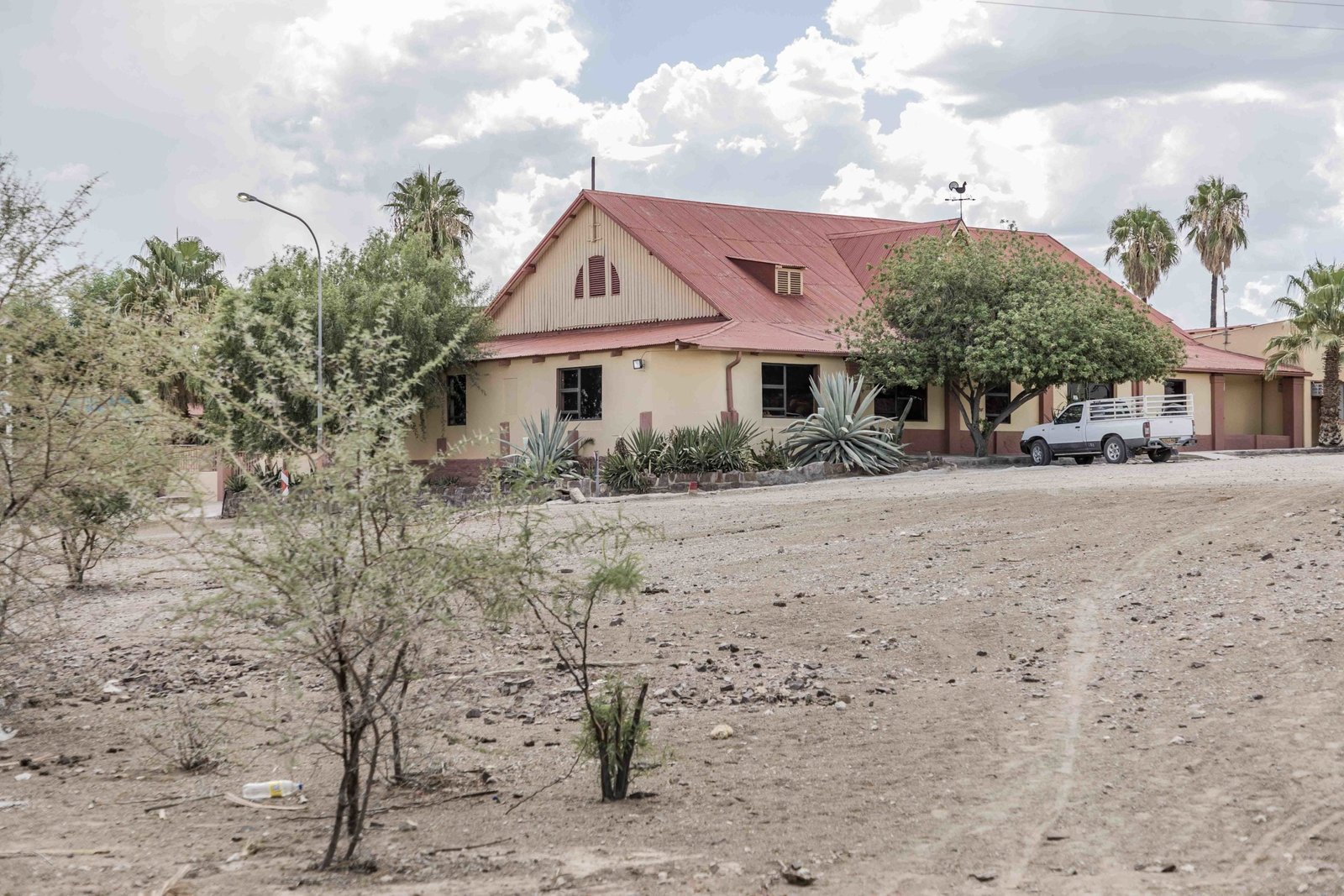
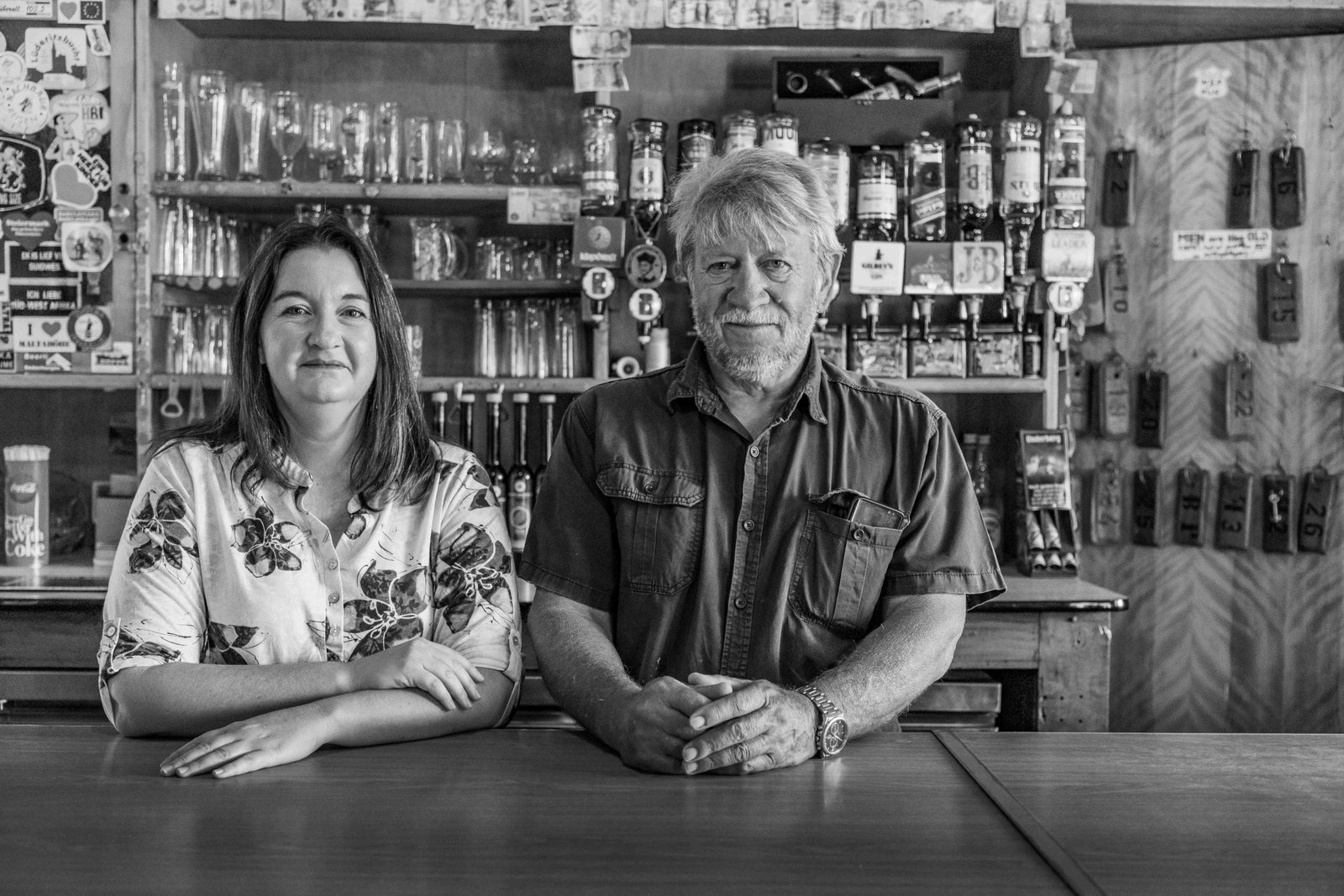
The hotel is frequented by the occasional farmer, by sundry locals from the district, and by travellers, such as we, passing through on whatever quest.
A heavy-set man in shorts is at the bar, hunched over a beer that looks small in his big hand. He turns his meaty head to me and asks: do I know how to lose money?
I am taken aback and don’t know what to say. “Of all the ways,” he goes on without waiting, “women are the nicest, horses are the riskiest. But farming,” he sighs, “ . . . farming is the surest!”
Then he goes back to his beer.
Another patron, sitting at a table where he has been served a meal (local steak: edible) had an air of patriarchy. Someone tells me in a hushed tone this man was once a farmer with vast herds of sheep and cattle, now reduced by droughts and bad government to a farm that cannot sustain itself. He tells me of a game farmer who opened his gates and let his antelope and zebra roam. He could no longer afford to feed them and felt his kindest act was to return them to the wild to fend for themselves.
There was an air of jollity in the bar, underlaid by a sadness that doesn’t go away yet will be ignored for as long as friends and strangers were welcomed with a bottle of beer from the fridge, and misfortune can be laughed at.
Marika has made a cordial from cactus. I buy a bottle from her, keen to try it.
“Be careful of that stuff, ”says Willi. “it will give you the squirts.”
“Ag, leave him, man, Willi,” says Marika. “He’s not a chicken!”
The next day, after a hearty farmer’s breakfast, the call of the road hangs in the dry air. We bid farewell to those who treated passing travellers as friends. I look back with a poignant note in my heart. I leave behind this brave and happy place that lives on the edge of tears.
The road leads deeper into the southern Namib, to Helmeringhausen. First, though, we detour to Schloss Duwisib. “Schloss” is German for “castle” and the imposing building stands in splendid and incongruous isolation on the arid plain. It was built, painstakingly, with European artisans and materials that were hauled 300 km from the nearest landing, across terrain without roads. Wagons of goods were drawn by oxen shod like horses to cope with the stony ground.
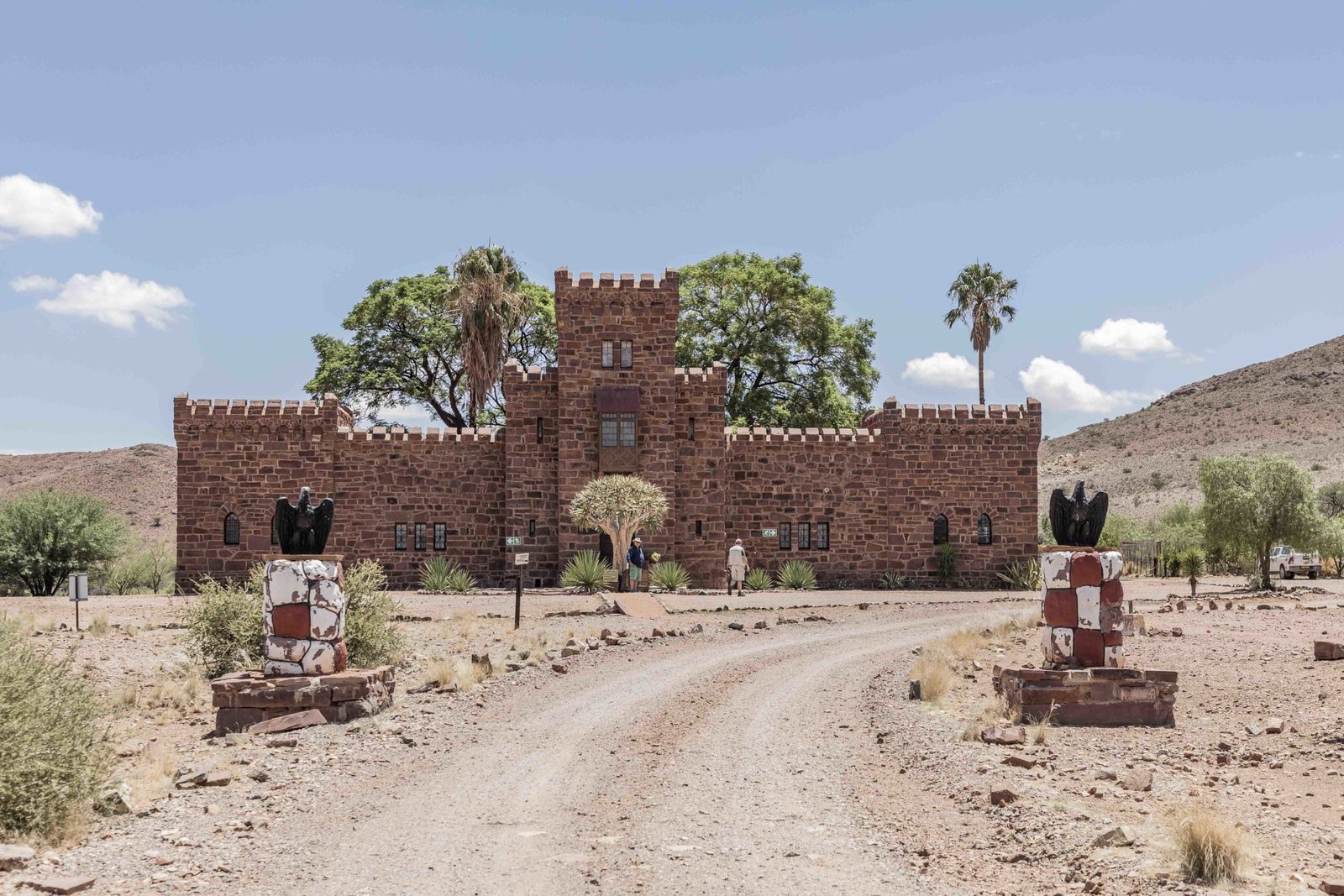
The effort was doomed. Completed more than a century ago, the owner, Baron Von Wolf, left his bride, daughter of the American consul in Germany, and answered the call of duty from Europe, then falling into the abyss of WW1. The hapless aristocrat was one of the first men to die in the opening battles of the conflict. His castle and land, despite the efforts of several subsequent dreamers, sank into neglect and disrepair.
Some decades ago it was rescued by the Namibian government, who spruced it up and turned it into an attraction for whatever desultory travellers might pass.
We hope for lunch and are cheered to discover the castle has a caretaker, and a canteen. We ask the custodian of the schloss whether we can lunch in the canteen. He shrugs. The canteen has neither food nor drink. Some distant bureaucrat has forgotten to supply the castle.
So we pull up under a sprawling old tree and lunch on what we find in our vehicles.
As we drive away, continuing our journey southwards to Helmeringhausen, we leave behind a lonely castle that never really belonged where it stands. Today it is another dream that has ended in the drylands, broken on the anvil of the desert.
Before very long, driving ever-south on the dusty road, we enter a village; our stop-over for the night. The village has a peculiar story. It is located on what is technically private land. The original owner of this land was a demobbed Schutztruppe officer called Hubert Hester who, one day, mused to himself: “I think I shall build a town.” And that, over the ensuing years in the early-to-middle 20th century, is exactly what the indefatigable Hubert Hester did.
He built the hotel we would spend the night in. He built the service station. He built the shop and he built the post office. It is said he did it mainly with his own hands. His buildings now line the 400 metres of the single street and constitute what is the town.
When he had finished he surveyed the result of his labour and he said: “I shall call this place after the town of my birth in Germany. I shall call it Helmeringhausen.”
We spend a pleasant evening in the Helmeringhausen hotel, thankful to Hubert Hester for the homespun but comfortable architecture and decor. In the morning I walk across the clean, sandy grounds. I come across one of the wagons used to transport men and goods to Schloss Duwisib. It’s not especially preserved as an artefact of an idiosyncratic history. It’s just standing there.
I fall into conversation with a German-born man working on a vehicle in the yard of the hotel. Our conversation gets round to why he is here, living in Helmeringhausen.
“I was immigrated into this country,” he explains helpfully. I make allowance for his grammar, although I say nothing. He knows what I am thinking. “I was brought here as a baby,” he goes on. “I had no say in it. I didn’t immigrate. I was immigrated.”
I withdraw respectfully from the conversation. After breakfast Andrew and I set off on the only road out of Helmeringhausen, heading west. We are to rendezvous with Christoph and Diane who had spent the night camping on a farm. I like the name of this farm. It is Sterreprag and means the splendour of stars. In the remote, dry skies the stars are strewn across the firmament like spilled jewels.
But our arrangements go awry and we miss Christoph and Diane.
Along the empty road the only people we saw were two road workers sitting around a three-legged pot at the side of the road. We see them again as we double back.
Christoph saw them, too. And being more canny than Andrew or I, Christoph stopped to ask them whether they saw us. They had. Moreover, they give Christoph a remarkably accurate description, not only of our vehicle, but also of Andrew and myself; and the direction we headed in.
Thanks to the men by the roadside Christoph and Diane and Andrew and I come in range of the walkie-talkies we carried and we meet up.
I mull over, yet again, how things work in this empty land. I sense an answer forming. It is an answer to a question I had when we set off on this odyssey: why do people choose to live what I think of as half-lives in these nearly dead and dying places?
I realise that I have been wrong again. These are not dead places, nor are they dying. They are simply what they have always been, a life unchanging. Life in the cities may be more complex but it’s a chimera. Urban life imposes a stultifying conformity. Even they who believe themselves to be unconventional live by an orthodoxy of non-conformism. Freedom is a phantom. We drink from a cup of our own illusions. It is the desert and the drylands that liberate you. It is here that you have to reconcile yourself to yourself. It is in the desert that you must fashion yourself from your own clay.
Prisoners without fences
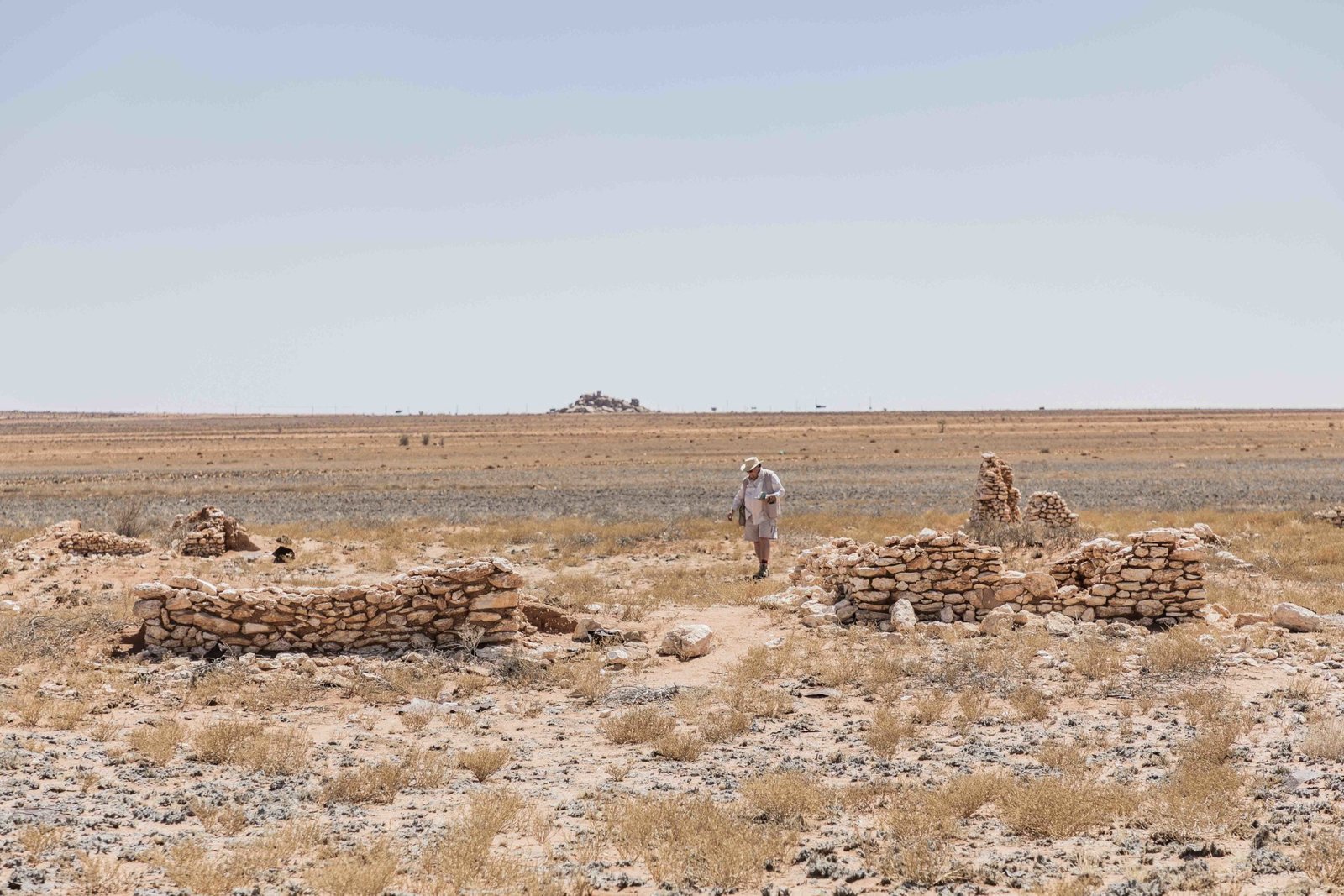
We reach the tiny settlement of Aus and now we are 700 km south of where we began, in Swakopmund. There is a break in the dune belt that has lain all this way between us and the coast. We can swing west and head for Lüderitz on the coast.
First, however, there is yet another ghost of the desert we must inspect. For it is at Aus that the Allies interned up to 1,500 German troops in a camp outside the town for the duration of WW1. Conditions in the camp appear to have been humane. There were no fences – the inhospitable desert plains being enough to dissuade anyone who got thoughts of ‘going somewhere’. In recognition of the dignity of the foe, officers were allowed to retain their sidearms, albeit without ammunition. The men eventually built stone houses. Some remains are visible today.
A peculiar consequence of the camp is that when the war ended and the Germans were free to return to their homeland in Europe, a significant number did not. They stayed on in the frontier land, becoming, mostly, stock farmers. Some also became traders and together they formed a keystone of the German community and the new economy in Namibia that survives into the present day.
Wild, wild horses

On we drive, across the white sands of the bleached desert. We keep a lookout, for we know there is life in this sterile terrain. And, soon enough, there they are: the wild horses of the Namib.
These horses constitute one of the very few feral horse populations in the world – and their origin is something of a mystery. Some people say they were turned loose when the Von Wolf farming venture at Duwisib collapsed. Others say they were the horses of the captured German troops and yet others say they were brought on the ships of the invasion fleet of South Africans that came to wrest German South West Africa from its colonial occupiers. Personally, I think any or all of the foregoing could be true. Scientific tests have been inconclusive and the horses live an unfettered life as a treasure and curiosity of the Namib. They benefit from supplementary feeding but other than that they are left to themselves. There is something about the presence of animals that roam unhindered by humans that frees the soul.
A hide has been built from which the horses can be observed. They seem unconcerned by our presence and they look at us with slightly less interest than we look at them.
A town of lonely souls
Lüderitz, the last stage in our bid for the forbidden fields of diamond dreams, looks strikingly like Swakopmund. It has the same German Gothic architecture and like Swakopmund it has been sadly bastardised by the charmless building of later decades. Lüderitz was once a destination for wild celebrants who came in from the diamond fields or came off the fishing boats with rich catches. Those days are gone and Lüderitz has traded in its boisterous past for a spiritless present.
Lüderitz is limited by the fact that it isn’t on the way to anywhere. A traveller needs a reason, wholly contained within Lüderitz itself, for going there. It seems a declining number of travellers find such a reason.
It is a forlorn little town.
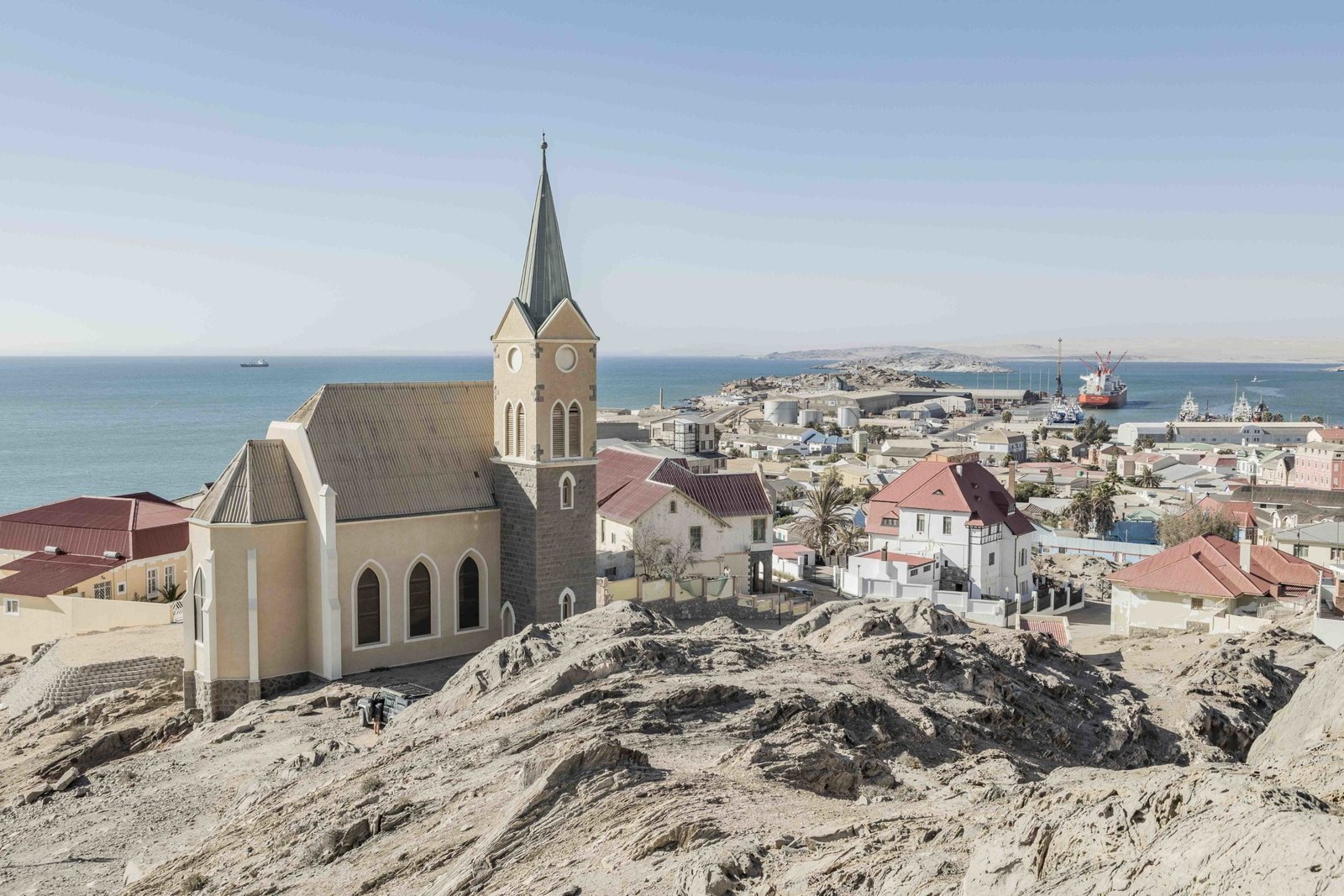

We, however, have our final venture in mind. We meet our guide, Ramon Druker. Ramon bears our written permission to enter the zone and once we were through the security gate and checkpoint we are in the world’s largest forbidden territory.
The drive soon enough becomes monotonous. There is sand, sand, and more sand. We pass a weather-beaten sign along the vague track we are following. It is a warning sign. It says: “sand”.
Occasionally there is s a stand-alone derelict building, with no clue to its former purpose.
In the lifeless domain there is no evidence of the mania that gripped the several hundred people who once populated the sandfields, aside from the handful of dilapidated buildings, loose corrugated iron roof sheets banging in the wind, and some rusted machinery of forgotten utility.
Yet the magic is here. The air is sombre and heavy with the riches that were grasped at and the dreams that died. At one time, on the floor of the Märchenthal (Valley of Fairy Tales) manic prospectors literally picked the diamonds up by hand. It was El Dorado. And it was theirs for the taking.
But, it was not to last. Partly it was that the diamonds were mined out; and partly it was that the outbreak of WW1 caused political upheaval.
Today the world is not short of diamonds. Their value is manipulated by money men in far-off capitals. The present-day owners of the Namibian fields retain a tight control. With no visible mining going on, this vast and trackless terrain seems to languish as some kind of insurance for some kind of rainy day.
Right then, however, we reach Pomona, the foremost of the two deserted mining towns. Pomona consists of a handful of houses – rather large, reflecting, no doubt, the aspirational status of the diamond-finders – and spaced far apart. There is a small graveyard for those who never left this place.

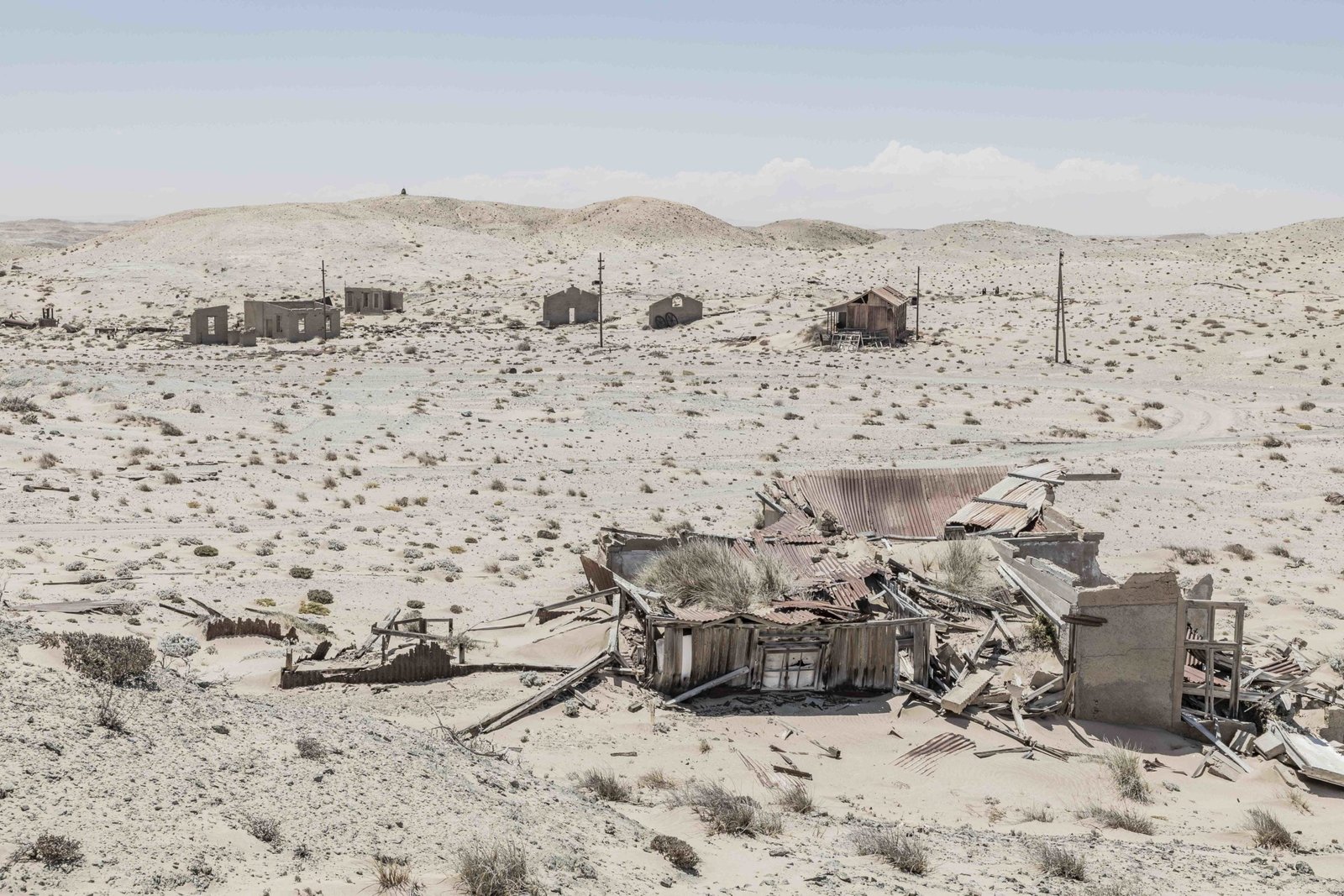
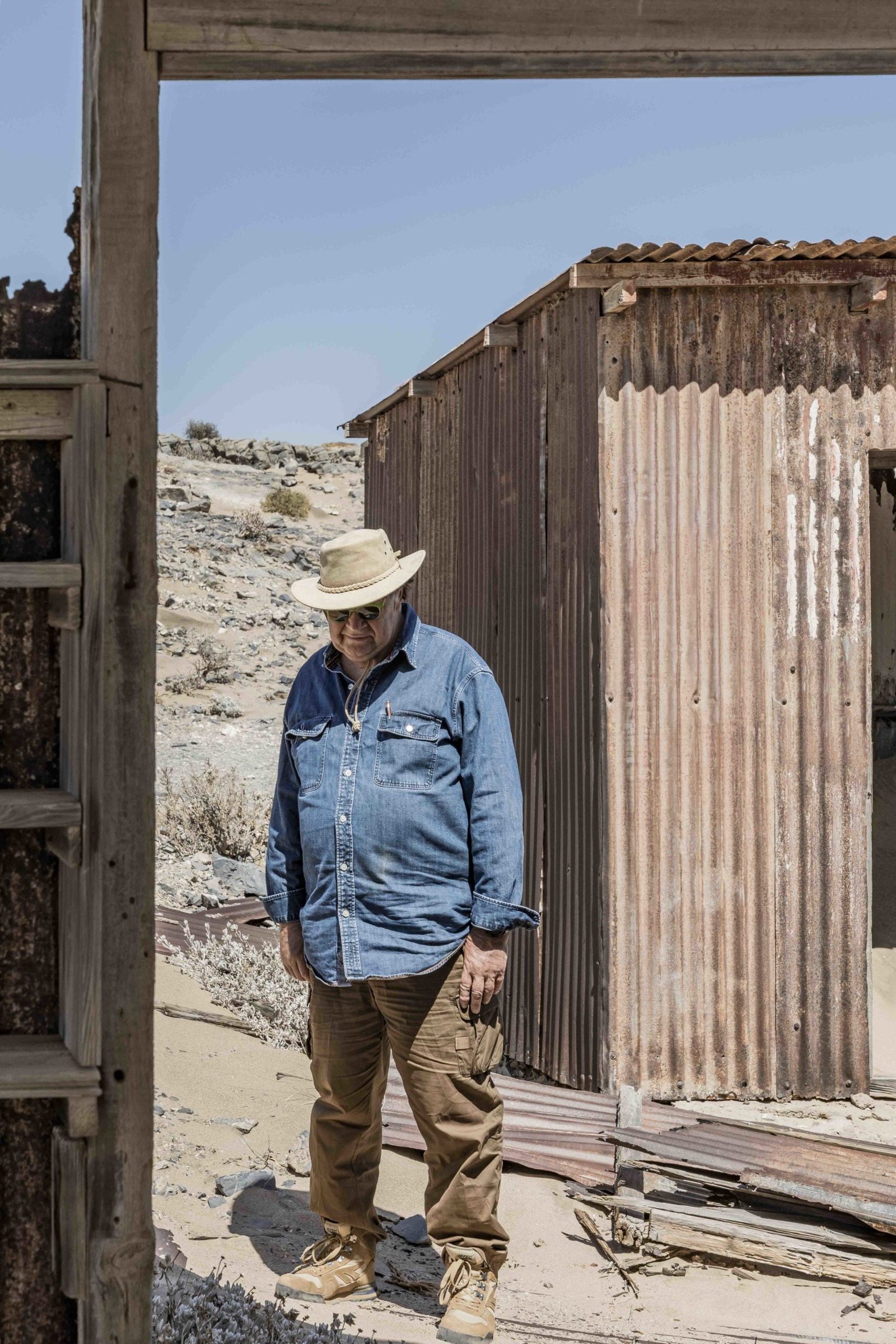
It is lunchtime and Ramon unpacks his four-by-four and carries some Tupperware containers of sandwiches and snacks into an unadorned room from which he had tried to sweep the sand. There sre some camp chairs and two folding tables pushed together, with plastic covers.
Ramon opens the containers and presents a welcome lunch. I notice there are condiments on the tables – ketchup, brown sauce, mustard and the like.
“I didn’t see you unpack these,” I say to Ramon.
“No,” he answers. “I leave them here.”
Well, why not? There iss no-one who might come by and take them. More disturbingly, there weren’t any animals that might come scavenging.
There is no life here.
I walk outside and stand on a sandy knoll. I look from horizon to horizon. There is no-one and there is nothing. I realise my journey has come to its end. This is nowhere. I have arrived.
The cruelty of riches The two most prominent figures in the story of the southern Namib are Adolf Lüderitz and August Stauch. They define their time and both were gripped by a fever for riches. Both were undone by it. Adolf Lüderitz searched for minerals before the presence of the diamonds was known. He believed copper was to be found. In his final expedition he set off in a small boat on the Orange River. Neither he nor his boat were seen again. It is fair speculation that during his searches he and his prospectors would have trod on diamonds strewn on the desert floor. It was August Stauch, a railway supervisor, who recognised the diamonds when they were brought to him by labourers. Stauch went on to become a man of fabulous wealth. In time, however, through bad investments, sheer bad luck, and the outbreak of WWl he effectively lost it all. He ended up living in a single room in his hometown in Germany. He was found on a park bench with, it is said, a few Deutschmarks in his pocket. He was taken to hospital and died a few days later.